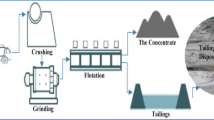Abstract
Resistivity imaging (RI) survey was carried out along two profiles in the Hingir-Rampur Colliery to assess how far it would be practical to extend the workings in Seam I towards the waterlogged previous workings, whilst leaving at least 60 m of coal between the two sections of mine. In order to corroborate the results of the geophysical survey, two boreholes were drilled along the profiles. Analysis confirmed hard, compact and dry strata between 60 and 146 m depth.
Résumé
Des tomographies de résistivité électrique ont été réalisées suivant deux profils dans la mine de charbon de Hingir Rampur afin d’évaluer dans quelle mesure il serait possible d’étendre les travaux miniers de la Couche I vers une zone de travaux précédemment ennoyés. En effet, une couche de charbon d’au moins 60 m d’épaisseur se trouve entre ces deux zones de travaux. Afin d’étalonner les mesures géophysiques, deux forages ont été réalisés au niveau de ces deux profils géophysiques. L’analyse a confirmé la présence d’une couche de charbon dur, compact et sec entre les profondeurs de 60 m et 146 m.




Similar content being viewed by others
References
Batayneh A, Al-Zoubi A (2000) Detection of a solution cavity adjacent to a highway in southwest Jordan using electrical resistivity methods. J.Enviorn Eng Geophhys 5:25–30
Daniels F, Alberty RA (1966) Physical chemistry. Wiley, New York
Dutta N, Bose R, Saikia B (1970) Detection of solution channels in limestone by electrical resistivity method. Geophys Prospect 18:405–414
Keller GV, Frischknecht FC (1966) Electrical methods in geophysical prospecting. Pergamon, Oxford
Militzer H, Rosler R, Losch W (1979) Theoretical and experimental investigations for cavity research with geoelectrical resistivity methods. Geophys Prospect 27:640
Panno S, Wiebel C, Heigold P, Reed P (1994) Formation of regolith-collapse sinkholes in southern Illinois: interpretation and identification of associated buried cavities. J Enviorn Geol 23:214–220
Singh KKK, Lokhande RD, Prakash A, Singh KB (2004) Multielectrode resistivity imaging technique for the study of coal seam. J Sci Ind Res 63:927–930
Smith D (1986) Application of the pole-dipole resistivity technique to the detection of solution cavities beneath highways. Geophysics 51:833–837
Verma RK, Bhuin NC (1979) Use of electrical resistivity methods for study of coal seam in parts of Jharia Coalfield, India. Geoexploration 17:163–176
Vincenz A (1968) Resistivity investigations of limestone aquifers in Jamaica. Geophysics 33:980–994
Acknowledgments
The author is very grateful to his Director for giving permission to publish this paper and to the Mine Management and Staff at Hingir-Rampur Colliery for providing the necessary facilities.
Author information
Authors and Affiliations
Corresponding author
Rights and permissions
About this article
Cite this article
Singh, K.K.K. Delineation of waterlogged area in inaccessible underground workings at Hingir Rampur Colliery using 2D resistivity imaging: a case study. Bull Eng Geol Environ 72, 115–118 (2013). https://doi.org/10.1007/s10064-012-0448-1
Received:
Accepted:
Published:
Issue Date:
DOI: https://doi.org/10.1007/s10064-012-0448-1



